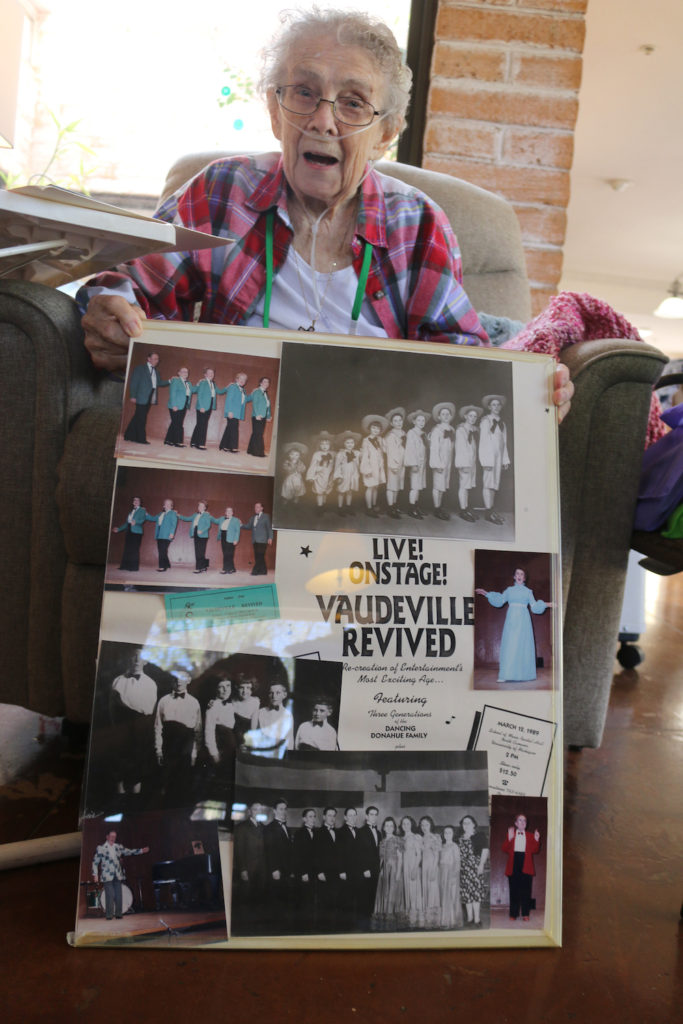TUCSON, Ariz. (CNS) — Sr. Barbara Donahue, 90, was only 10 minutes into an interview about the vaudeville group made up of her and her siblings when she broke out in “The Donahue Song.”
The ditty was written by her mom for the group, which became its signature piece, emphasizing the importance of family.
“We were just ordinary people trying to do extraordinary things,” said Sr. Barbara Donahue, who is a member of the Sisters for Christian Community.

She was talking to Catholic Outlook, Tucson’s diocesan newspaper, as she looked back on memorabilia from her childhood when she and her siblings were the “Nine Dancing Donahues.”
Sr. Barbara, who had her 90th birthday in September, lives at El Rancho Encanto assisted living center in Tucson. She was diagnosed recently with lung cancer. She’s the last survivor of the troupe.
Born Sept. 14, 1929, she was the youngest of five boys and four girls growing up in Detroit. Her dad, Emmett, was a bricklayer by trade, but supported his family with his job at the Plymouth auto factory. Her mom, Ella, was the musical genius. She graduated from St. Aloysius School and played the organ in church.
“St. Aloysius was the root of all that happened,” Sr. Barbara said.
“Her early occupation was to play at the silent movies,” she said about her mother. When the oldest child, Emmett Jr., turned 7, she put him to work as “an Irish tenor.”
“When she would play, he would sing,” Sr. Barbara said.
Later, someone approached her and suggested that they form a family vaudeville group, and the “Nine Dancing Donahues” were born. After Emmett Jr. came Jack, Dennis, Thomas, Richard, Betty, Kay, Nancy and Barbara.
“Our sponsor was the Kennedy Milk Company,” she said with a grin.
Her dad was the stage manager, Sr. Barbara recalled. His greatest challenge was trying to keep the girls’ shoes properly organized offstage as they switched between their tap and stage shoes.
Retirement Fund for Religious
National Collection Dec. 7-8 at parishes
The group was prominent in the Detroit area, especially among the Irish parishes. It broke up in 1945 when the U.S. entered World War II. Three brothers entered the military and Barbara entered the convent. She entered the Sisters of St. Joseph of Kalamazoo, Michigan, at age 16, taking the name Sister Mary Leah. She joined her current community after the Second Vatican Council.
In 1949, the University of Michigan sponsored a vaudeville show that included the siblings’ group. Even though she was preparing for her vows, Sr. Barbara said, she was allowed to return to join the reunion.
During their touring days, each child had a song. Hers was “Alice Blue Gown,” from the play “Irene” as sung by 1930s’ Hollywood star Alice Faye. She even has a photo of her singing in a blue gown at age 15.
Nancy and Kay sang “East Side, West Side,” Sr. Barbara recalled. That was usually preceded by her brother Denny singing “Ain’t She Sweet?”
Whenever a local parish sponsored a fundraiser, the “Nine Dancing Donahues” was there in a pinch, she said.
The signature song, “The Donahue Song,” became a family mainstay, so much so that those who marry into the family are not really members until they attend a special ceremony with the family at the Irish American Club in Detroit. Family members encircle the newcomer and sing “The Donahue Song.”
“Then you are in the family,” Sr. Barbara said.
When Ella died Sept. 8, 1953, her obituary ran the following week in Billboard magazine, the entertainment industry periodical of record.
Sr. Barbara marveled at the amount of detail she still remembers from her early days. “All this is extraordinary. I paid a lot of attention apparently.”
The theater skills came in handy in ministry, especially during her time serving at the San Solano missions in the Tucson Diocese. “I was always regarded as a good teacher,” she said.
She repeated a mantra she learned from her mother: “If you see a need, step up to it.”
Sr. Barbara said when she was growing up, people always knew the location of the Donahue house. A fire hydrant stood in front, so the city also placed a streetlight nearby to help first responders during nighttime emergencies.
“We were always out there playing baseball,” she said.
More than seven decades after the troupe broke up, one memory was as strong as the day it started, said Sr. Barbara, the last surviving member. “The wonderful part of this was family.”
— By Michael Brown, Catholic News Service. Brown is managing editor of Catholic Outlook, newspaper of the Diocese of Tucson.






